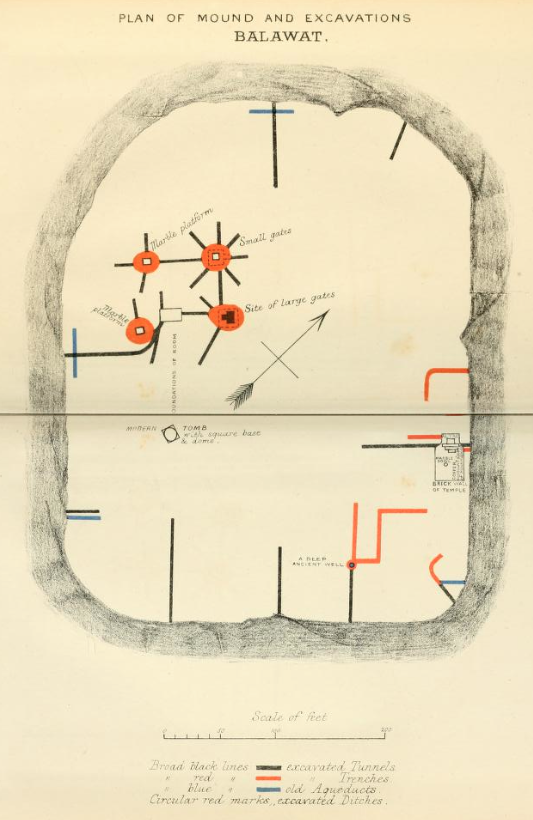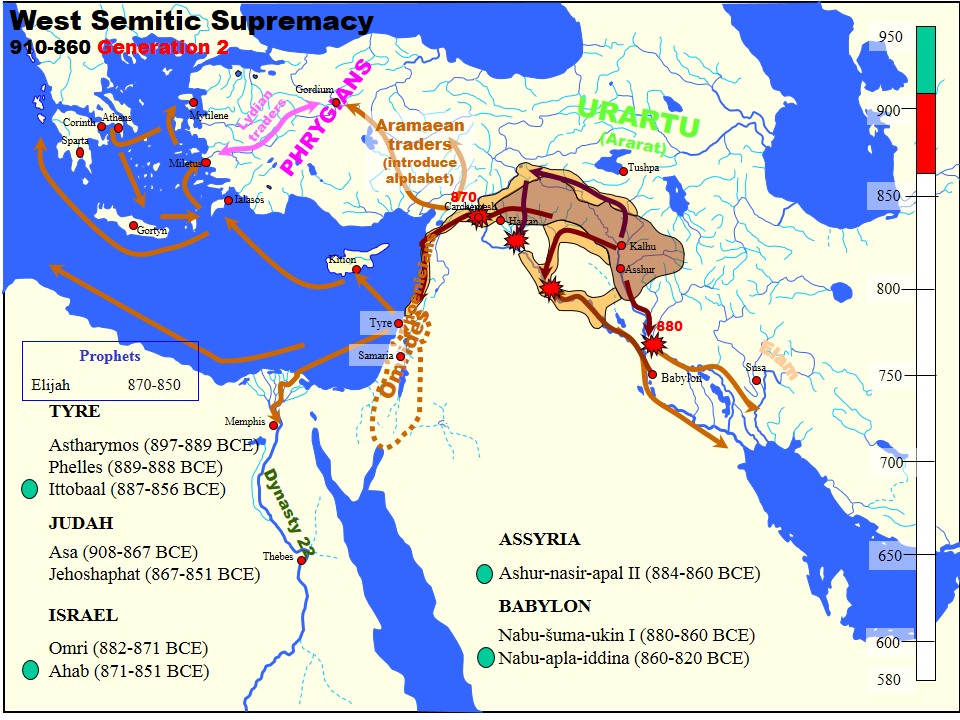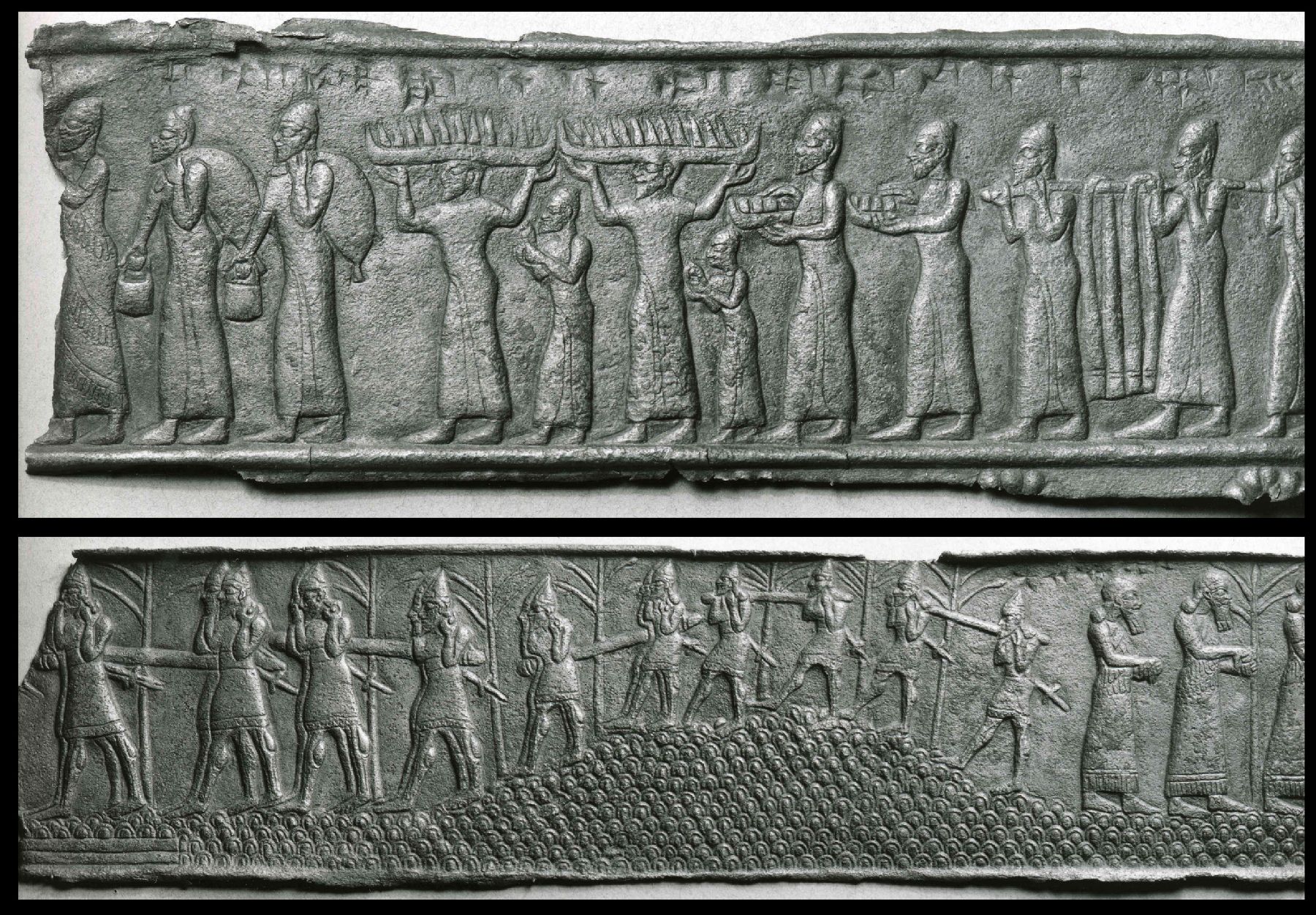|
Balawat
Balawat ( syc, ܒܝܬ ܠܒܬ, ') is an archaeological site of the ancient Assyrian city of Imgur-Enlil, and modern village in Nineveh Province (Iraq). It lies southeast from the city of Mosul and to the south of the modern Assyrian town of Bakhdida. Ancient name Balawat is the site of the ancient Assyrian city of Imgur-Enlil. The meaning of Imgur-Enlil is "Enlil agreed". Note that there was also a wall in ancient Babylon named Imgur-Enlil. History of archaeological research The site was excavated in 1878 by archaeologist Hormuzd Rassam. The site was again excavated by Max Mallowan for the British School of Archaeology in Iraq in 1956. A surface survey was conducted by D. J. Tucker in 1989 for the British Museum. The town walls enclosed an area of around 64 hectares. Occupation history The city of Imgur-Enlil was founded by the Neo-Assyrian king Ashurnasirpal II (884-859 BC). It lay up the Derrah river from the Tigris, where the city of Kalhu (Biblical Nimrud/Calah) was situa ... [...More Info...] [...Related Items...] OR: [Wikipedia] [Google] [Baidu] |
Balawat Gates
The Balawat Gates are three sets of decorated bronze bands that had adorned the main doors of several buildings at Balawat (ancient Imgur-Enlil), dating to the reigns of Ashurnasirpal II (r. 883–859 BC) and Shalmaneser III (r. 859–824 BC). Their extensive use of narrative art depicting the exploits of Assyrian kings has cemented their position as some of the most important surviving works of art of the Neo-Assyrian Empire, comparable to the extensive Assyrian palace reliefs. When the Neo-Assyrian Empire fell in 614-612 BC, Balawat was destroyed. The wooden elements of the gates decomposed, leaving only the bronze bands (some of which were badly damaged). The remains of two sets of gates can be found in the British Museum's collection, those from the Temple of Mamu are housed in the Mosul Museum. Small sections of the Shalmaneser bronze door bands are also in the Louvre Museum at the Walters Art Museum in Baltimore [...More Info...] [...Related Items...] OR: [Wikipedia] [Google] [Baidu] |
Ashurnasirpal II
Ashur-nasir-pal II (transliteration: ''Aššur-nāṣir-apli'', meaning " Ashur is guardian of the heir") was king of Assyria from 883 to 859 BC. Ashurnasirpal II succeeded his father, Tukulti-Ninurta II, in 883 BC. During his reign he embarked on a vast program of expansion, first conquering the peoples to the north in Asia Minor as far as Nairi and exacting tribute from Phrygia, then invading Aram (modern Syria) conquering the Aramaeans and Neo-Hittites between the Khabur and the Euphrates Rivers. His harshness prompted a revolt that he crushed decisively in a pitched, two-day battle. According to his monument inscription, while recalling this massacre he says: Following this victory, he advanced without opposition as far as the Mediterranean and exacted tribute from Phoenicia. On his return home, he moved his capital to the city of Kalhu (Nimrud). Family Ashurnasirpal II's father was Tukulti-Ninurta II. His son and successor was Shalmaneser III. His queen was Mullissu-muk ... [...More Info...] [...Related Items...] OR: [Wikipedia] [Google] [Baidu] |
Balawat Excavation Plan 1882
Balawat ( syc, ܒܝܬ ܠܒܬ, ') is an archaeological site of the ancient Assyrian city of Imgur-Enlil, and modern village in Nineveh Province (Iraq). It lies southeast from the city of Mosul and to the south of the modern Assyrian town of Bakhdida. Ancient name Balawat is the site of the ancient Assyrian city of Imgur-Enlil. The meaning of Imgur-Enlil is "Enlil agreed". Note that there was also a wall in ancient Babylon named Imgur-Enlil. History of archaeological research The site was excavated in 1878 by archaeologist Hormuzd Rassam. The site was again excavated by Max Mallowan for the British School of Archaeology in Iraq in 1956. A surface survey was conducted by D. J. Tucker in 1989 for the British Museum. The town walls enclosed an area of around 64 hectares. Occupation history The city of Imgur-Enlil was founded by the Neo-Assyrian king Ashurnasirpal II (884-859 BC). It lay up the Derrah river from the Tigris, where the city of Kalhu (Biblical Nimrud/Calah) was situa ... [...More Info...] [...Related Items...] OR: [Wikipedia] [Google] [Baidu] |
Bakhdida
Qaraqosh, also known as Al-Hamdaniya or Bakhdida, is an Assyrian city in Iraq within the Nineveh Governorate, located about 32 km (20 mi) southeast of the city of Mosul and 60 km (37 mi) west of Erbil amid agricultural lands, close to the ruins of the ancient Assyrian cities Nimrud and Nineveh. It is connected to the main city of Mosul by two main roads. The first runs through the towns of Bartella and Karamlesh, which connects to the city of Erbil as well. The second, which was gravel until being paved in the 1990s, is direct to Mosul. All of its citizens fled to Kurdistan Region after the ISIS invasion on August 6, 2014. The town was under control of ISIS until October 19, 2016 when it was liberated as part of the Battle of Mosul after which residents have begun to return. Local Assyrians speak the Qaraqosh dialect of Northeastern Neo-Aramaic. Etymology The present name of the town, Qaraqosh, is first attested in a source from the sixteenth century. It is of Tu ... [...More Info...] [...Related Items...] OR: [Wikipedia] [Google] [Baidu] |
Hormuzd Rassam
Hormuzd Rassam ( ar, هرمز رسام; syr, ܗܪܡܙܕ ܪܣܐܡ; 182616 September 1910), was an Assyriologist and author. He is known for making a number of important archaeological discoveries from 1877 to 1882, including the clay tablets that contained the ''Epic of Gilgamesh,'' the world's oldest notable literature. He is widely believed to be the first-known Middle Eastern and Assyrian archaeologist from the Ottoman empire. Later in life, he emigrated to the United Kingdom, where he was naturalized as a British citizen, settling in Brighton. He represented the government as a diplomat, helping to free British diplomats from captivity in Ethiopia. Biography Early life Hormuzd Rassam was an ethnic Assyrian, born in Mosul in Upper Mesopotamia (now modern northern Iraq), then part of the Ottoman Empire. His father was a member of the Chaldean Catholic Church. and his grandfather, Anton Rassam, from Mosul, was archdeacon in the Chaldean Catholic Church. His mother Theres ... [...More Info...] [...Related Items...] OR: [Wikipedia] [Google] [Baidu] |
List Of Cities Of The Ancient Near East
The earliest cities in history were in the ancient Near East, an area covering roughly that of the modern Middle East: its history began in the 4th millennium BC and ended, depending on the interpretation of the term, either with the conquest by the Achaemenid Empire in the 6th century BC or with that by Alexander the Great in the 4th century BC. The largest cities of the Bronze Age Near East housed several tens of thousands of people. Memphis in the Early Bronze Age, with some 30,000 inhabitants, was the largest city of the time by far. Ebla is estimated to have had a population of 40,000 inhabitants in the Intermediate Bronze age. Ur in the Middle Bronze Age is estimated to have had some 65,000 inhabitants; Babylon in the Late Bronze Age similarly had a population of some 50,000–60,000. Niniveh had some 20,000–30,000, reaching 100,000 only in the Iron Age (around 700 BC). In Akkadian and Hittite orthography, URU became a determinative sign denoting a city, or combined ... [...More Info...] [...Related Items...] OR: [Wikipedia] [Google] [Baidu] |
Nineveh Governorate
Nineveh Governorate ( ar, محافظة نينوى, syr, ܗܘܦܪܟܝܐ ܕܢܝܢܘܐ, Hoparkiya d’Ninwe, ckb, پارێزگای نەینەوا, Parêzgeha Neynewa), also known as Ninawa Governorate, is a governorate in northern Iraq. It has an area of and an estimated population of 2,453,000 people as of 2003. Its largest city and provincial capital is Mosul, which lies across the Tigris river from the ruins of ancient Nineveh. Before 1976, it was called ''Mosul Province'' and included the present-day Dohuk Governorate. The second largest city is Tal Afar, which has an almost exclusively Turkmen population. An ethnically, religiously and culturally diverse region, it was partly conquered by ISIS in 2014. Iraqi government forces retook the city of Mosul in 2017. Recent history and administration Its two cities endured the 2003 U.S.-led invasion of Iraq and emerged unscathed. In 2004, however, Mosul and Tal Afar were the scenes of fierce battles between US-led troops an ... [...More Info...] [...Related Items...] OR: [Wikipedia] [Google] [Baidu] |
Shalmaneser III
Shalmaneser III (''Šulmānu-ašarēdu'', "the god Shulmanu is pre-eminent") was king of the Neo-Assyrian Empire from the death of his father Ashurnasirpal II in 859 BC to his own death in 824 BC. His long reign was a constant series of campaigns against the eastern tribes, the Babylonians, the nations of Mesopotamia and Syria, as well as Kizzuwadna and Urartu. His armies penetrated to Lake Van and the Taurus Mountains; the Neo-Hittites of Carchemish were compelled to pay tribute, and the kingdoms of Hamath and Aram Damascus were subdued. It is in the annals of Shalmaneser III from the 850s BC that the Arabs and Chaldeans first appear in recorded history. Reign Campaigns Shalmaneser began a campaign against the Urartian Kingdom and reported that in 858 BC he destroyed the city of Sugunia and then in 853 BC also Araškun. Both cities are assumed to have been capitals of the Kingdom before Tushpa became a center for the Urartians. In 853 BC, a coalition was formed by 11 sta ... [...More Info...] [...Related Items...] OR: [Wikipedia] [Google] [Baidu] |
Kirkuk
Kirkuk ( ar, كركوك, ku, کەرکووک, translit=Kerkûk, , tr, Kerkük) is a city in Iraq, serving as the capital of the Kirkuk Governorate, located north of Baghdad. The city is home to a diverse population of Turkmens, Arabs, Kurds, and Assyrians. Kirkuk sits on the ruins of the original Kirkuk Citadel which sits near the Khasa River. Kirkuk was proclaimed the "capital of Iraqi culture" in 2010. It is claimed by the Kurdistan Regional Government as its capital. Kirkuk is also considered by Iraqi Turkmens to be their cultural and historical capital. The government of Iraq states that Kirkuk represents a small version of Iraq due to its diverse population, and that the city is a model for coexistence in the country. Etymology The ancient name of Kirkuk was the Hurrian ''Arrapha'' During the Parthian era, a ''Korkura/Corcura'' ( grc, Κόρκυρα) is mentioned by Ptolemy, which is believed to refer either to Kirkuk or to the site of Baba Gurgur from the city. Since ... [...More Info...] [...Related Items...] OR: [Wikipedia] [Google] [Baidu] |
Assur
Aššur (; Sumerian: AN.ŠAR2KI, Assyrian cuneiform: ''Aš-šurKI'', "City of God Aššur"; syr, ܐܫܘܪ ''Āšūr''; Old Persian ''Aθur'', fa, آشور: ''Āšūr''; he, אַשּׁוּר, ', ar, اشور), also known as Ashur and Qal'at Sherqat, was the capital of the Old Assyrian city-state (2025–1364 BC), the Middle Assyrian Empire (1363–912 BC), and for a time, of the Neo-Assyrian Empire (911–609 BC). The remains of the city lie on the western bank of the Tigris River, north of the confluence with its tributary, the Little Zab, in what is now Iraq, more precisely in the al-Shirqat District of the Saladin Governorate. Occupation of the city itself continued for approximately 4,000 years, from the Early Dynastic Period to the mid-14th century AD, when the forces of Timur massacred its predominately Christian population. The site is a World Heritage Site, having been added to that organisation's list of sites in danger in 2003 following the conflict that erupt ... [...More Info...] [...Related Items...] OR: [Wikipedia] [Google] [Baidu] |
Babylonians
Babylonia (; Akkadian: , ''māt Akkadī'') was an ancient Akkadian-speaking state and cultural area based in the city of Babylon in central-southern Mesopotamia (present-day Iraq and parts of Syria). It emerged as an Amorite-ruled state c. 1894 BCE. During the reign of Hammurabi and afterwards, Babylonia was called "the country of Akkad" (''Māt Akkadī'' in Akkadian), a deliberate archaism in reference to the previous glory of the Akkadian Empire. It was often involved in rivalry with the older state of Assyria to the north and Elam to the east in Ancient Iran. Babylonia briefly became the major power in the region after Hammurabi ( fl. c. 1792–1752 BCE middle chronology, or c. 1696–1654 BCE, short chronology) created a short-lived empire, succeeding the earlier Akkadian Empire, Third Dynasty of Ur, and Old Assyrian Empire. The Babylonian Empire rapidly fell apart after the death of Hammurabi and reverted to a small kingdom. Like Assyria, the Babylonian state retained t ... [...More Info...] [...Related Items...] OR: [Wikipedia] [Google] [Baidu] |
Medes
The Medes (Old Persian: ; Akkadian: , ; Ancient Greek: ; Latin: ) were an ancient Iranian people who spoke the Median language and who inhabited an area known as Media between western and northern Iran. Around the 11th century BC, they occupied the mountainous region of northwestern Iran and the northeastern and eastern region of Mesopotamia located in the region of Hamadan (Ecbatana). Their consolidation in Iran is believed to have occurred during the 8th century BC. In the 7th century BC, all of western Iran and some other territories were under Median rule, but their precise geographic extent remains unknown. Although they are generally recognized as having an important place in the history of the ancient Near East, the Medes have left no written source to reconstruct their history, which is known only from foreign sources such as the Assyrians, Babylonians, Armenians and Greeks, as well as a few Iranian archaeological sites, which are believed to have been occupied ... [...More Info...] [...Related Items...] OR: [Wikipedia] [Google] [Baidu] |





%2C_(033)_der_geladene_Gastredner_Athiel_al-Nudschafi%2C_Gouverneur_von_Ninive.jpg)



